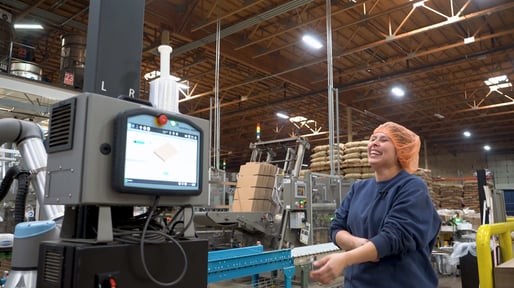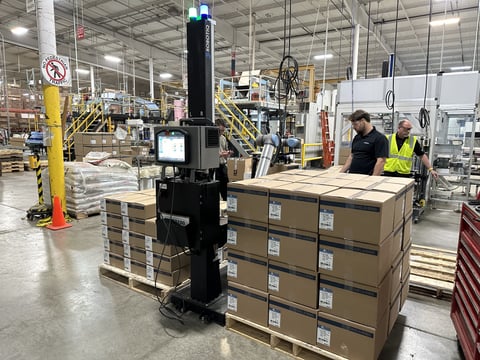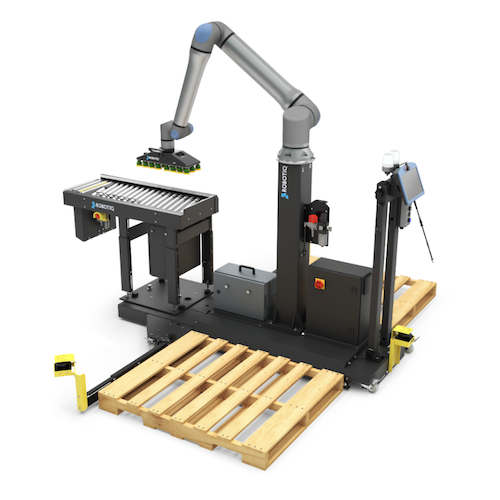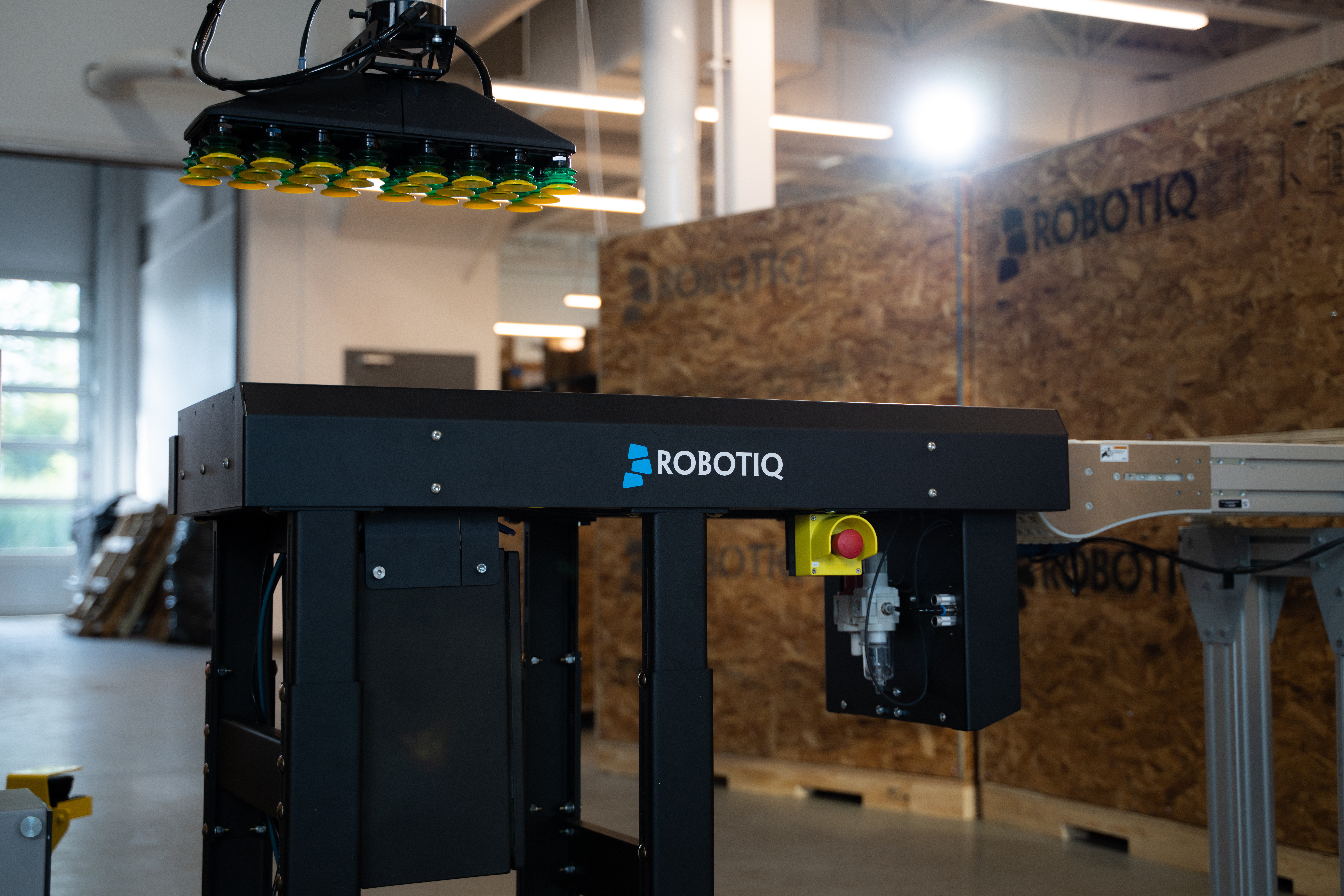Overcoming Barriers to Palletizing Automation
.png)
Posted on Aug 02, 2023 in Palletizing
6 min read time
Automation is revolutionizing the manufacturing sector, with palletizing being a key area of focus. However, the path to full automation is not without its challenges. This article explores the barriers to palletizing automation from a global perspective, drawing on insights from industry experts.
Customization and Integration Costs
The perceived high cost of robot cell implementation is a barrier to automation. Many businesses still hold the idea that implementing a robot cell costs upwards of $500,000. This perception can deter companies from investing in automation, despite the long-term benefits and cost savings it can provide. In reality, implementing a palletizing cell can cost less than half of the previously mentioned amount.
Of course, manufacturers need to keep in mind the actual costs of automation, but they should consider the return on investment (ROI) it offers more. It's important to note that the calculation of ROI is not the same for every business. For instance, a recent client, Cascade Coffee, had their own criteria for evaluating the return on their investment. CFOs should also explore different financing options and incentives available for automation projects. In fact, in some countries, businesses can obtain financial support from their government to automate their processes and implement new technologies. For example, the ROI for implementing six palletizing cells in the plant of a coffee co-packer was only 13 months.
Operator Resistance and Misconceptions
Resistance from operators can also hinder automation projects. This resistance often stems from misconceptions about robots, such as the belief that they will take up too much space, pose a threat to worker safety or, even worse, take the place of these workers. These misconceptions can be addressed through education and demonstration of collaborative robots (cobots) designed to work safely alongside humans.
.jpg?width=508&height=339&name=Robotiq%20Palletizing%20Solution_031_Teach%20Pendant_04-2021%20(1).jpg)
When workers fear losing their place to the profit of robots, it is important to emphasize the fact that robots aim to replace them only in jobs that no one wants to do and that pose risks to their health and safety. Not to mention the repetitive and dull nature of these tasks. Then, they can focus on added-value tasks and grow into better-paid positions.
Manufacturers should prioritize reskilling the existing workforce in digital and automation technologies in any future-of-work discussions. Manufacturers would greatly benefit to provide support to help employees adapt to the technology or involve them in the decision-making process so that they feel invested in the company’s success.
Workforce Quality and Aging Population
The quality of the workforce and the aging population are significant barriers to automation. The U.S. Chamber of Commerce highlights a labor shortage in the most impacted industries, including manufacturing. Indeed, the manufacturing industry faced a major setback after losing roughly 1.4 million jobs at the onset of the pandemic. Since then, the industry has struggled to fill job vacancies. As of March 2023, there were 693,000 open manufacturing jobs. This shortage is exacerbated by an aging population, leading to a lack of skilled workers available for physical tasks such as palletizing.
Automation is an excellent way for business managers to show their appreciation for all team members: reducing physical constraints and simplifying processes contributes to extending the life of workers and making their job more satisfying.
Manufacturers would benefit from investing in training and upskilling their workforce to meet the demands of automation. They should also consider strategies to attract younger workers to the industry, such as promoting the innovative and high-tech nature of modern manufacturing.

Multiple Projects and Lack of Knowledge
Having several different projects running in parallel can delay automation projects. It's common for project managers to prioritize other projects over palletizing tasks, leading to delays in automation implementation. Often a different task is selected to automate first, however the time, effort, and cost put into the implementation can lead to an incomplete cell. In the end, an incomplete cell brings no value to the business and operation.
A lack of knowledge about the simplicity of automation for tasks like palletizing can also be a barrier. Businesses often don't know where to start or try to automate everything at once, leading to delays or a status quo. It is thus important to prioritize automation projects to gain productivity. Manufacturers need to take a step-by-step approach to automation, starting with tasks that can provide quick wins and significant ROI.
Also, keep in mind that you are not alone in this project! To ensure everything goes smoothly, businesses choosing Robotiq solutions can count on a worldwide network of trustworthy partners. Robotiq and its partners are used to train end-users so they are fully autonomous but more importantly, comfortable working with and around robots.
Budget Constraints
Budget constraints, especially in times of financial difficulties, can delay or block automation projects. Businesses need to plan their budgets carefully and take into consideration the long-term cost savings and efficiency gains that automation can provide.
Postponing an automation project and continuing production while facing labor issues can lead to significantly higher costs.
Task Complexity and ROI
Did you know that palletizing automation can be implemented independently, without having to automate other processes? Automation doesn't have to be an all-or-nothing proposition. Starting with one task, such as palletizing, can provide significant benefits and pave the way for further automation.
The automation of palletizing is also a good, well defined, low-risk task for a first collaborative robot in your business. If you have been looking for years on how to implement a cobot in you operation, this is a good solution.
In many businesses, it's common for the operator responsible for palletizing to also execute other tasks, such as box filling, taping, or labeling. Businesses often want to automate all these tasks simultaneously to get a decent ROI, which can create undesirable delays.
Palletizing is a repetitive, physically demanding task that is well-suited to automation. By automating this task, businesses can immediately improve efficiency, reduce the risk of worker injury, and free up operators to focus on more complex tasks. This can lead to improved productivity and quality, as well as increased job satisfaction for operators.
Moreover, the ROI from automating palletizing can be substantial. Automated palletizing systems can operate around the clock, significantly increasing output compared to manual operations. They also provide consistent performance, reducing errors and waste. Over time, these benefits can more than offset the initial investment in automation.
Furthermore, starting with palletizing can serve as a valuable learning experience, helping businesses understand how to implement automation effectively. This can make it easier to automate additional tasks in the future, further increasing ROI.

Looking Forward
Overcoming the barriers to palletizing automation requires a comprehensive approach that includes workforce training, cost education, operator engagement, project prioritization, and strategic planning. By addressing these challenges, businesses can reap the benefits of automation, including improved efficiency, cost savings, and enhanced competitiveness.
As we move forward, it's essential to remember that the automation revolution is not a destination but a journey. It requires continuous learning, adaptation, and investment. The future of manufacturing lies in automation, and the time to embrace it is now.
And remember, you are not alone. We are here to guide you through the process. We have done this hundreds of times. We guarantee minimal production downtime and complete satisfaction.
To learn more about palletizing, it’s this way!


-modified.png)


-2.jpg)

Leave a comment